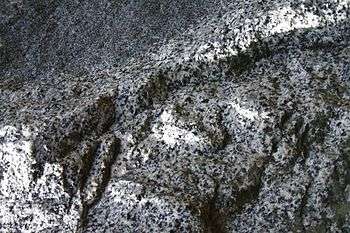Half Dome Granodiorite

Half Dome Granodiorite is granodiorite (see also granite) found in a region on and near Half Dome, in Yosemite National Park, California, United States. The granodiorite forms part of the Tuolumne Intrusive Suite (aka Tuolumne Batholith), one of the four major intrusive suites within the Sierra Nevada.
What rocks comprise it
The granodiorite has large crystals of biotite, hornblende, and both feldspars — orthoclase and plagioclase. The space between crystals tends to be filled with quartz. The hornblende tends to have large, over 0.5 in (1.27 cm) rectangular crystals. The biotite forms hexagonal "blocks," up to 0.25 in (6.35 mm) across. A knife blade can peel the edges.
Sphene is found in Half Dome Granodiorite. The grains are honey-colored, and large at 0.25 in (6.35 mm) across,.[1]
Its age
Half Dome Granodiorite traces to early Late Cretaceous. It age is between 85 to 83.4 (+/-1 to 2%) Ma, with average age of 84.1 Ma. It is younger than Sentinel granodiorite (88.4 Ma), and older than Cathedral Peak granite (83.7 Ma).[2] Half Dome Granodiorite is the Valley's youngest plutonic rock,.[3]
Where found, specifically
Half Dome Granodiorite is the most common Yosemite Valley rock, east of Royal Arches and Glacier Point,.[3]
Half Dome Granodiorite is the innermost major unit of the Tuolumne Intrusive Suite.

See also
- Cathedral Peak Granodiorite
- El Capitan Granite
- Geology of the Yosemite area
- Kuna Crest Granodiorite
- Sentinel granodiorite
- Tuolumne Intrusive Suite
References
- ↑ Glazner, Allen F, Stock, Greg M. (2010). Geology Underfoot in Yosemite. Mountain Press, p. 50. ISBN 978-0-87842-568-6.
- ↑ Evernden, J.F., Curtis, G.H., and Lipson, J. (1957). "Geologic Unit: Half Dome". Retrieved 7 May 2016.
- 1 2 N. King Huber (1987). "The Geologic Story of Yosemite National Park". Retrieved 9 May 2016.

